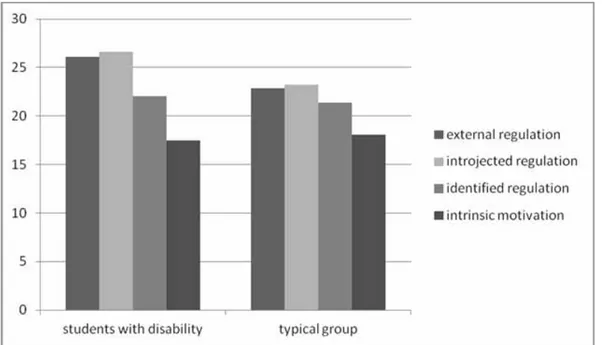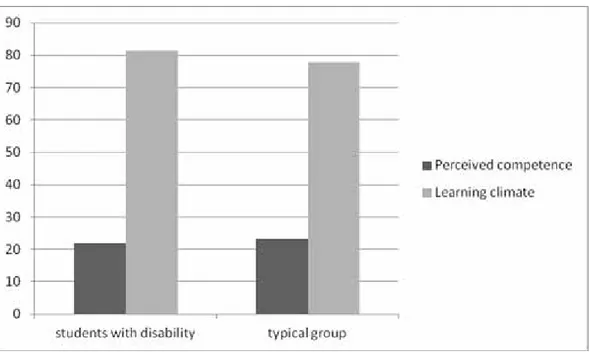DOI: 10.4018/IJDLDC.2018010104
Copyright©2018,IGIGlobal.CopyingordistributinginprintorelectronicformswithoutwrittenpermissionofIGIGlobalisprohibited.
Active Learning and
Self-Determination for the Management
of Differences in the Classroom
Oliva Patrizia, Department of COSPECS, University of Messina, ItalyAnna Maria Murdaca, Department of COSPECS, University of Messina, Italy Assunta Penna, Department of COSPECS, University of Messina, Italy
ABSTRACT Thecontextsofactivelearning,betheycooperativeorflipped,areconsideredenvironmentsinwhich effectiveformsoflearningaredevelopedandstudentsreportgreatersatisfactionofbasicpsychological needs,intrinsicmotivation,andinterestinthesubjectsstudiedcomparedtothepeersincludedinclasses withtraditionalteachingmethods.Theaimofthisstudyistoinvestigatewhethertherearedifferences betweenstudentswithdisabilitiesandwithoutanypathology,includedinactivelearningcontexts, inthelevelofsatisfactionofbasicpsychologicalneeds,intheperceptionofskills,intheperception oftheclassroomclimateandinthemotivationtolearn.100students(age:M=16.99;DS=1.808), 33withdisabilitiesand67studentswithtypicaldevelopmentwereinvolved.Theresultsconfirmed, inadditiontotheimpactofindividualfactorsinthemotivationtostudy(psychologicalneedsand perceptionofskills),asignificantrelationshipalsoemergedwiththeclassroomclimate,withthe teachingstrategiesofactivelearningandfunctionalandself-determinedlevelsofmotivationtostudy. KeywoRDS
INTRoDUCTIoN Inthestudyofactivetechnologicalskills,specificallyflippedclassroomandcooperativelearning, aspedagogicalmodelscapableofproducingeffectsontheself-determinationofstudentswithand withoutdisabilities.Thisisawayoftacklingalltheobstaclestolearningthatcanbefacedbyour children,sothattheycanbeactivesubjectsoftheirlearning.Thisisaconceptofmediastrategy, suitabletoimplementtheconstructionofknowledgebytheboysatthesametime.Thisis,of course,amodificationofthedynamicsoftheclass,aswellasofthinkingbythestudentandthe useofpsychologicalprocessessuchasattention,perceptionandexecutiveskills,inparticular,the perceptualcategorizationofconceptsandthought,whichdevelopsneuropsychologicalarchitecture thatneedsmediatedandhighlysupportivelearningcontextstomakeitselfexplicit.Instorytelling,the approachinthe“flipped”classroommovesinparticularwithitsmodelanditsinnovativestrategies, andwithitslanguagesandrelationalmodalitiesthatensureaprocessofinformation,thusfostering thedevelopmentofeverythingineachsubject.Theflippedclassroom,inparticular,werepeat,favors greaterpersonalization,asthestudentswholiveandworkinaninvertedclassareactivatedaccording totheirownrhythms,theirtimes,andaboveall,reciprocity.Inaddition,asAsh(2012)pointsout,the term“flipping”referstotheideaofexchangingclassworkassignments,aswellasleadingstudentsto actwithgreaterresponsibilityinthedirectionofenhancinglearninganditsbasicprerequisites.Thisis whythisapproachentersaspaceforreflectionwithininclusiveeducation,enrichingtheeducational-didacticpracticeofnewstrategicmethodsthatcombinetheanalogicallevelwiththepragmaticone, formingadidacticmediationthatisfundamentalfordevelopingprocessesofunderstanding,thatis, mentaloperationsasbasesfortherepresentationalconstructionofknowledge.Infact,itisprecisely withinthespaceoftheupside-downclassroomwithtechnologicalmediationthatthesubjectwill bestimulatedtomodifytheschemesinhispossessiontoenvisagenewoperationalpossibilities tofacethemanyinputsandtasksimposedbyanemergingsituation.Inshort,thegoalistomake transactionsbetweenhissystemofpreconceptionsandhisexperiencemediatedbyawholeseriesof strategiestowhichheissubmittedtoachievesignificantgoalsinknowledgeandatthesametime toself-regulatehisbehavior. Infact,untilrecently,thefrontallessonwasconsideredthecentralelementofthedidacticactivity, whiletoday,inaschoolemptiedofitstraditionalformative-cognitivefunction,theexposurephase ofthecontentshasbecomelessrelevantthanthatoftheirsharingandinteriorization.Theworking phaseofactivelearningintheclassroomwiththestudentsisnolongerbasedonmemorization andmechanicallyrepetitiveactivitiesbutontheactiveconstructionofknowledgethroughspecific researchmethodologies,problemsolving,anddecision-makingactivities.Thedisciplinarycontents arenot,therefore,simplypresentedtothestudentsbutmadetobuildthroughaprocessofrediscovery andreinventionthatnaturallyisnotspontaneousbutguidedbytheteacher.Onlyafterthisphase doesexposuretothecontentsbecomeuseful,evenintraditionalforms.Workathomealsointeracts withtheactivitiescarriedoutintheclassroom.Infact,throughin-depthstudiesandresearchonthe topicsofthelectures,thestudentsconnectthevariousacquiredinformation,whichwillthencompare withtheteacher,experimentingwithstrategiestoacquireincreasinglyrefinedandself-determined knowledgeessentialtoensuretheconsolidationoflearningintheshort-termandlong-term(Fulton, 2012).Obviously,digitalcontent,videolessons,orparticulartechnologicaltoolssuchasFacebook, Twitter,YouTubeandSkypecouldbeadequatelydesignedandusedtofacilitatecollaborativelearning intheflippedclassroom.Infact,theinvertedclassmodelcanenhancecollaborativelearning,through whichstudentslearnandbuildtheirknowledgethroughgroupinteractionandareledbytheteacher intodeeplearningactivities. Theuseofteachingstrategiesalternativetofrontalteachingfacilitates,therefore,theacquisition ofautonomyandskills,basicandtransversal,andindirectlycontributestoincreasedmotivationand self-esteem.However,itistruethat,insomecases,theuseofinnovativedidacticsmaybedifficult, notfunctionalorineffectiveiftheskillsoftheteacherand/orstudentsareinadequatetothetask
requestedoriftheteachingmethodologyisincompatiblewiththecognitiveneeds,emotionaland behavioral,oftheclass.Therefore,itisessentialtocarryoutacarefulevaluationbeforechoosing themostappropriateteachingmethodandtocalibratetheteachingbasedonstudents’realpotential andexpectationsinordertoimproveandmaintainthestudents’learningandself-determinationat highlevels. Inthisregard,theabilitytochooseanddecideeffectivelyisoneofthemostimportantskills thatstudentsshouldbeabletomasterforsuccessatschoolandinprofessionallife.Promotingself-determinationisthereforetheframeworkwithinwhichtoteachstudentshowtomakeeffectivechoices anddecisions,thatis,choicesthatareimportanttothestudentandthatareadvantageousforhim, especiallyinthefuture(Deci&Ryan,1985;Ryan&Deci,2000;Wehmeyer,1992). Atthispoint,itisinterestingtoaskwhichteachingpracticesaremostsuitabletopromoteself-determinationandfacilitatethedecision-makingprocessandself-regulatedlearninginstudents. Self-determinationisacombinationofskills,knowledgeandbeliefsthatpushesthesubject tocommittoachievingagoal,throughself-containedandself-regulatedbehaviorsandactions. Understanding,therefore,one’sstrengthsandlimitsisessentialforself-determinationandfor individualperceptionofeffectiveness.Self-awarenessfavorsinthesubjectagreaterabilitytocontrol hisownlifeandhispresentandfutureactions,andgreaterself-determination.Thiscanandmust becometheessentialobjectiveofeveryeducationalpath,whichisrealizedthroughtheuseofteaching thatgoesbeyondthetraditionalteacher–learnerrelationshipandthatratherinvolveseveryone—teacher andstudents—inacircularanddynamicrelationshipabletofacilitatetheemergenceofdeepand complexskills,suchasdecisionmaking,cooperationandself-regulation.If,infact,teachingwas supportedbystudents’self-determination,thiswouldsubstantiallyfacilitatelearningnotonlyto absorbcontentbutalsotogainotherskills,rangingfromself-awarenesstotheabilitytoenterinto relationshipswithothers. Inthisregard,numerousstudiesemphasizethatmanyoftheskillsandcompetenciesofself-regulatedlearningandself-determinationareinfactsupportedbythedynamicinteractionthatis activatedbetweenthevarioussubjectsinvolvedinthelearningprocess.Infact,theself-regulatedand self-determinedstudentsarethosewhoshowthemselvestobemostcompetentinthemanagementof socialrelationsandintheabilitytocollaborateandcooperatewithpeers(Newman,2002). Thisiswhyitisfundamentaltoencouragemoreteachingandlearningtechniquesaimedat promotingprosocialandcollaborativeskills,inthebeliefthatcooperatingisanalternativestrategy ofproactive,self-regulatedandorganizationallearningthatfacilitatestheachievementofautonomous andsuccessfulperformance(Chen,2002). Organizationallearningandtheflippedclassroombecomethereforenotonlymodelstobe inspiredbythestartofprocessestoimprovemanagementpracticesbutalsooperationalschemesto organizecontinuouslearningprocessesinordertoencouragethestrengtheningoftheself-reflexive capacityoftheclassgroup.Alearningthatbecomesanexpressionofthequalityofteachertraining that,inaflexibleandattentivemanner,mustrereadtheneedsandexperiencesthatcontinuallyemerge fromthecontextinwhichtheyfindthemselvesacting.Itisobviousthatinordertoachievethis,itis necessarytoenterthegearofthenew,turningmoreattentionandavailabilitytonewtechnologies, tocolleagues,andatthesametimelookingatthestudentasaperson,thatis,asasubjectwithrights andduties,asafuturecitizen,andasatravelingcompanion—asubjectthatisnotonlyinteractive, butalsocooperativethroughhischoices,theexpressionofhisneeds,andhisinvolvementindecisions concerninghimself.
Self-Determination Theory and Active Learning Contexts
Muchscientificevidencesupportstheeffectivenessofeducationalstrategiesactiveinpromoting academicperformance.Alongsidethislineofresearch,however,therearestudiesthatdemonstrate howintrinsicmotivationisthekeytoachievingbetteracademicperformance.Helpingstudents findanintrinsicpurposeinthestudyactivityimproveslearninginvariouswaysandenableshigher
performance.Theself-determinationtheory(SDT)ofDeciandRyan(1985,2000)suggeststhat satisfyingthreebasicpsychologicalneedsistheessentialrequirementfortheconstructionofintrinsic motivation.Thesearetheneedforautonomy,relationshipandcompetence.Thenewwayofconceiving learninggoestowardsawayofworkingcenteredonthelearnerandawayfromthateducationalprocess derivedfromtheteacher.Enablingstudentstotakepartindecisionmakingandsharingtasksand responsibilitieswiththemincreasesthefeelingofautonomyandself-determination.Toachievethis, pupilsmustactresponsibly;responsibilitycanbetaughtandlearned,butteachingmustbesystematic andcontinuous(Dyson,2002).Amethodologythat,ashasbeenwidelysaid,fostersresponsibility amongstudentsispreciselythecooperativelearningthat,associatedwiththeflippedclassroom, directsthestudentstocollaborationandteamwork,promotesmotivationandencouragesstudentsto becomeautonomousandindependentintheirstudies(Tayloretal.,2014;Liu,Wang,&Ryan,2016). Thecontextsofactivelearning,betheycooperativeorflipped,areconsideredenvironments inwhicheffectiveformsoflearningaredevelopedandstudentsreportgreatersatisfactionofbasic psychologicalneeds,intrinsicmotivationandinterestinthesubjectsstudiedcomparedtothepeers includedinclasseswithtraditionalteachingmethods,thatis,lectures(Hanze&Berger,2007;Lo& Hew,2017;Sergisa,Sampsonab,&Pelliccione,2018).Furthermore,theperceptionofcompetenceand thefeelingofbeinganactivepartofalearningcommunitycertainlycontributestohigherperformances (Beachboard,Beachboard,Li,&Adkinson,2011;Kostarisetal.,2017).Thesenseofbelongingand communityintegrationhasinfactbeenrepeatedlyconfirmedasoneofthemajorpredictorsofthe schoolcareerandprofessionalpreparation(Abeysekera&Dawson,2015;Seery,2015). Insummary,thestudies,withsomedifferences,haveshownthatengaginginactivelearning activitiesprovidesstudentswiththeopportunitytoexperiencecompetence,relationshipsandautonomy andpromotesgreatercommitmentinthestudents,thatis,thewillingnesstocontinuestudyingand showinginterestintheproposedactivities.Moreover,theconfirmationofthelinkbetweenthe satisfactionofthebasicpsychologicalneedsofcompetence,relationshipsandautonomyandscholastic/ academicsuccessisconfirmedbymany.Theseindicationsareusefulforresearchersinthefieldof motivationaltheories,activelearningandvocationaltraining,aswellasforprofessionalsinvolvedin theplanning,executionandevaluationofeducational-teachingprograms.Infact,thestudiescontribute tobroadentheknowledgeabouttheapplicationoftheSDTineducationalcontexts,especiallyfor thoseinvolvedinteachingastheyexplainthemotivationalprocessesunderlyingtheactivelearning groups.Consequently,knowingwhatmotivationmechanismsareandidentifyingthefactorsthat canfavororhindereffectivelearningcanmotivateeducationprofessionalstoengageinthistypeof teachingactivity,despitethechallengesanddemandsofcommitmentandadditionalresourcesthat complexlearningcontextsrequire. Insummary,educationalprojectsthatinvolvegroupsofstudentsshouldbeconsideredaneffective approachtoimprovinglearningandteachinginschoolsatalllevels,astheyimproveacademic engagementandmeetthebasicneedsofstudents.Aparticularattentiontotheplanningphaseis necessarybecausetheeffectivenessofactivelearningrequiresacarefulchoiceofthetopicstobe treated,whichmustbestimulatingandlinkedtoreality,thecreationofnetworksamongthestudents toguaranteetherelationship,theassignmentofresponsibilitiesandfunctionalrolestothegroup, aswellasthefreedomofself-organizationofteamprocesses,aswellasafunctionaluseofnew technologies,whileensuringthatindividualstudentsreceiveadequatesupportfromtheirclassmates andteacher(Bishop&Verleger,2013;Giannakos,Krogstie,&Chrisochoides,2014;Lo&Hew,2017). Disabled Students and Active Learning Contexts
Thestudiescarriedoutoverthelastfewyearsoninclusiveschoolsystemsandonmulti-dimensional inclusionassessmentmodels(Pavone,2014;Cottini,2017)havehighlightedhowtheimplementation ofinclusiveeducationshouldtranslateintoinnovativeandeffectiveteachingpractices,basedon themotivationandself-determinationofdisabledstudentsandonthedesignofsupportivelearning contexts.Thisgoesinthedirectionofthewell-beingandthethinkability/constructionofalifeproject thatreallymeetstheneedsofstudents,withandwithoutdisabilities,toaspiretoanindependentand
self-determinedlife.Amongthe“qualities”thatidentifyascholasticcontextasmotivatingthereis preciselythepresenceofaclasswithstructuresandfunctions,valuesandnormsthatenhancestudents’ abilities,astheyoptimizedevelopment,adaptivebehavior,theirperformanceandpsychological well-being. Allthismakesusopenoureyestotheimportanceoffavoringtheself-determinationofpeoplewith disabilities,sothattheycanfeelsatisfiedwiththemselves,whotheyareandwhattheydo,developing andexploitingtheirresourcesandimprovingtheirqualityoflife.Unfortunately,asdocumentedby extensiveliterature,subjectswithdisabilitiesarenotgiventheopportunitytomakechoicesand havepreferences.Itisimportant,infact,tokeepinmindthateveryperson,regardlessofintellectual levelanddisability,hasresources,aswellaspreferencesandprevailinginterests,andhastherightto achievewhathewants,ratherthanwhatotherswantandexpect.Fewteachers,althoughworking,in theiropinion,inaninclusivemanner,believethattheskillsandknowledgerelatedtothepromotion ofself-determinationaretoocomplextobelearnedbythestudents,andthereforeaprioritheydo notpreparetooffereducationalopportunitiestomanagestudentdiversityandenhancedifferences nordotheyusevariousdevicestotransformskillsintoskillsthatareusefulinlife,norconsequently theysucceedinoutliningclearobjectivesoflearningprogression.Thisisbecausetheseteachersare incapableofmanagingcomplexlearningconditions,whichshouldbeorientedtobringoutindividual characteristicsofeachinthedirectionofafullrealizationoftheindependentlifeproject. Assumingtheinclusiveschool,themodelofself-determinationmeans,therefore,tosetup learningcommunitiesthatprovideopportunitiesforallstudentstoactivelyparticipateinclass life,aswellastoencourageformsofcollaborationbetweenteachersaimedatdecodingindividual differencesandtothechoiceofdiversifiedstrategiestomeettheeducationalneedsofthestudents. Itisthereforenecessarytothinkfromtheperspectiveofinclusivedesign,whichisself-determined andthereforedoesnotoriginatefromalistofpredefinedactivitiesandconstraintsinrigidtemporal termsbutisreceptive,creativeandorientedtotheexpectationsofthepersonandhispersonalgoals. Inpractice,strategicteachingskillsarerequiredtoconstructalternativecurricularpaths,whereself-determinationisconfiguredasatransversalskilltobeacquiredtoachievedeepandself-regulated learning.Workingatschoolontheimplementationofself-determinationmeanscreatingacontext ofmediation.Learningtouseself-determination,learningtobeself-determinedrequiresachangeof perspective;onlytheteacherwhoisconvincedthateachstudentcangobeyondthestateheisinand walksinthedirectionofdevelopingthepotentialofthestudentswillfindandcreatetheconditionsfor thistohappen.So,whatarethehypotheticalstepstoimplementself-determination?howtostructure learningenvironments,howtobuildeffectivepractices? Ifitistruethatbeingself-determinedmeanstoperceivecausalagentsoftheirownpathofchange andlearning,itisequallytruethatweneedtooutlineamodusoperanditoimplementproactivity throughperson-centeredplanning,pre-knowledgeofpupils,andexperienceasastartingpoint—on identifyingpeople’svaluesandtheiractiveinvolvement(Wehmeyer,1992;Ryan&Deci,2000).The aimistohelpthedisabledstudenttoachievesignificantlifegoalsbasedontheresourcesavailable, personalinterestsandindividualandsocialsenseofaccomplishment. Inthisdirection,pedagogicalmodelsofcooperativeandflippedlearningcanpresentthemselvesas validalternativestotraditionalteaching,sincetheyfocusonthepotentialofthelearnerandnotonthe quantumofdisabilityandlimitationsthatthepupilindifficultypresents.Infact,theuseofcollaborative practicesandtheactivationoftheflippedclassroomrespondsadequatelytotheeducationalneeds ofallstudents,throughasortofconnectivepedagogythatunderlinestheimportance,onthepartof theteacher,ofusingmoreteachingstylesanddiversifiedteachingstrategiestoinvolveallstudents andfacilitatetheirlearning(Corbett,2001).Theactivelearningcontextsaimtotrainindependent pupilsabletoidentifyproblemsandsolvetheminrealsituations,touseskillsandproceduresto solvecomplexproblems,totransfertheacquiredknowledgeindifferentcontexts;capableofproblem solving,activeparticipation,collaborationandcooperation,acquisitionandtransferofknowledge throughaconscioususeofnewtechnologies.
Asforstudentswithdisabilities,thefocusbecomesthedesignofthefundamentalpointonwhich teacherscanreflecttoevaluatethesuccessoftheirstudents’learning.Itisnecessarytotakeinto considerationthestartinglevelofthestudentsinrelationtotheeducationalobjectivestobeachieved, thelevelofdifficultyofthetasks,themonitoringofprogressandtheavailabilityofeducational supportstructures(Morrissey&Semmel,2001;Stough&Palmer,2003).Intermsofactualteaching, astrategycapableofproducingpositiveresultsconsistsinmakingthechildrenworkinsmallgroups andadjustingthedifficultiesofthetasktothestudents’abilities.Toteachcomplexconcepts,the proceduresandteachingmaterialsshouldbeclearandexplicit,sothateveryonecanunderstand, rememberandmasterthecontentseffectively,ratherthandeducingfrompreviousexperiencesor theworkofothers(Knight,2002;Paulsen,2005)andtheflippedclassroomandcooperativelearning certainlylendthemselvestothispurpose(Vaughnetal.,2000). Nevertheless,itisfurthernecessarytoinvestigatesomeaspectsthathavenotyetbeenstudied; infact,althoughtherehasbeenresearchinvestigatingtherolethatcertainindividualandcontextual variables(self-determination,self-efficacy,andclassclimate)haveintheeducationalcontext,few studiesstillinvestigatethesefactorsinyoungstudentswithdisabilitiestogetherwitheducational aspectsanddidacticsimplementedbytheteacher(activemethodologies),thatis,thetruebarometer oftheteachers’competencies,whicharesubstantiatedintheirabilitytofacecontextsofsupportive learningandconsequentlytoevaluatetheprogram. Aims Theaimofthisstudyistoinvestigatewhethertherearedifferencesbetweenstudentswithdisabilities andwithoutanypathology,includedinactivelearningcontexts,inthelevelofsatisfactionofbasic psychologicalneeds,intheperceptionofskills,intheperceptionoftheclassroomclimateandin themotivationtolearn. Participants Thegroupconsistedof100students(age:M=16.99;DS=1.808)residingintheprovinceof Messina,Italy(44.1%)andinsomeprovincesofCalabria(55.9%).Specifically,itinvolved33 studentswithdisabilitiesand67studentswithtypicaldevelopment,attendingthelastthreeyearsof secondaryschoolsofseconddegree.Inparticular,50%ofstudentsattendedahighschool,23.5% atechnicalinstituteand26.5%aprofessionalinstitute.Foryoungpeoplewithdisabilities,inmost cases,theywerestudentswithlearningdisabilitiesorwithslightintellectualdeficits.Thegroupof studentsconsistedof37malesand31females.Allthestudentswereplacedinclasseswhoseteachers frequentlyappliedboththeflippedclassroommethodologyandcooperativelearningactivities,for implementingthestudentknowledgeandimprovingthedegreeofself-determinationandmotivation tolearninthesocio-emotionalareas(motivation,self-efficacyandinteraction).
MATeRIALS AND PRoCeDURe
Beforeproceedingwiththecompletionofthequestionnaires,theinformedconsentwasdeliveredto besignedbytheparents(forunderagestudents).Anonymousprotocolswerepreparedanddelivered tothestudents.Theparticipantsweremetinsmallgroupsandtheadministration,conductedina singlesession,engagedthemforabout30minutes. Eachstudentwasaskedtocompletethefollowingquestionnaires: LCQ—LEARNINGCLIMATEQUESTIONNAIRE(WilliamsandDeci,1996).Thisisa questionnairecomposedof15itemsaimedatmeasuringthesupportforautonomyandcompetence thatthestudentreceivesfromtheirteacher.ScoreswereawardedviaaLikert7-pointscalefrom1 (“Stronglydisagree”)to7(“Stronglyagree”). PCS—PERCEIVEDCOMPETENCESCALE(WilliamsandDeci,1996).Thisisashort questionnairethatevaluatesthestudent’sperceptionoftheirfeelingsofcompetenceaboutlearning
andengagementintheclassroom.ThescoreswereawardedonaLikert7-pointscalefrom1(“Not atalltrue”)to7(“Verytrue”). SRQ-A—ACADEMICSELF-REGULATIONQUESTIONNAIRE(RyanandConnell,1989). Thistool,composedof32items,evaluatesstudents’motivationtostudy.Thescoresareexpressed ontheLikert4-pointscalefrom1(“Notatalltrue”)to4(“Verytrue”). BPNS—BASICPSYCHOLOGICALNEEDSSCALE(Kasser,Davey,&Ryan,1992).This isaquestionnairecomposedof21itemsaimedatmeasuringbasicpsychologicalneeds,suchas competence,autonomyandrelationality,througha7-pointLikertscalefrom1(“Notquitetrue”)to 7(“Verytrue”).
ReSULTS AND DISCUSSIoN
Giventhenatureofthedata,itwasdecidedtoproceedwithastatisticalanalysisofnon-parametric data.Specifically,theMann-Whitneytestwasusedtocalculatethedifferencesbetweenthegroups, whileforthecorrelationstheSpearmancorrelationtestwasused.
BPNS - Basic Psychological Needs Scale
Table1showsthemeansandstandarddeviationsofthescoresobtainedintheBPNSquestionnaire. Fromthedifferentialanalysisbetweensubjectswithandwithoutdisabilities,thesubjectswith disabilityperceivedlesssatisfactionoftheirneedforautonomy[U=310,000;Z=-3.288;p=.001], whiletheyperceivedgreaterrelation[U=328,500;Z=-3.063;p=.002]comparedtotheirtypical developmentpeers.However,intermsofcompetence,bothgroupsconsideredthisbasicpsychological needlargelysatisfied(Figure1).
SRQ-A - Academic Self-Regulation Questionnaire
Table2showsmeansandstandarddeviationsofthescoresobtainedintheSRQ-Aquestionnaire. FromtheanalysisofthedataobtainedfromtheSRQ-A,itisclearthatsubjectswithdisabilities exhibitedahigherexternalregulation[U=408,000;Z=-2.083;p=.037]andagreaterintrojected regulation[U=385,000;Z=-2.367;p=.018]comparedtothegroupofstudentswithoutany pathology.Thistendencybyyoungpeoplewithdisabilities—toregulatetheirbehavior(inthiscase, thestudy)mainlyonthebasisofthrustsandstimulicomingfromoutside—couldbethegeneral consequenceoftheveryfrequentuseofeducationalandrehabilitativepractices,which,onthebasis ofincentivesandreinforcements,pushesthemtochangetheirbehavior(Figure2).
PCS - Perceived Competence Scale (LCQ) - Learning Climate Questionnaire
Table3showsthemeansandstandarddeviationsofthescoresobtainedfromthePCSandLCQ questionnaires. FromtheanalysisofthedataobtainedfromthePCSandtheLCQ,nosignificantdifferences emergedbetweenthegroupsofchildrenwithandwithoutdisabilitiesintheperceptionofskills[U =486,000;Z=-1.137;p=.256].Furthermore,thereseemstohavebeennodifferencebetween thegroupsintheperceptionoftheclassclimate,understoodintermsofsupportforautonomyand competence[U=500,500;Z=-0.945;p=.345](Figure3). CoRReLATIoNS Thecorrelationsweremadeforseparategroups.
Individual Factors (Basic Psychological Needs and Skills Perception) and Learning Self-Regulation
Regardingthegroupofstudentswithdisabilities,fromthecorrelationalanalysisbetweenthe differentfactorsinvestigatedpositivecorrelationsemergedbetweentheperceptionofskillsandthe basicpsychologicalneedsofautonomy[r=.405;p=.016],ofcompetence[r=.357;p=.035]and Table 1. Means and Standard deviation of BPNS
Groups Autonomy Competence Relation
studentswithdisabilityM
DS 33,977,536 28,515,782 40,645,492
typicalgroupM
DS 39,127,313 30,946,490 7,66437,5
Figure 1. Psychological need
Table 2. Means and Standard deviation of SRQ-A
Groups External
Regulation Introjected Regulation RegulationIdentified MotivationIntrinsic
Studentswith
disability DSM 26,115.810 26,636.625 22,034.866 17,515.354
Typicalgroup M 22,85 23,24 21,36 18,06
oftherelation[r=.611;p=.000].Theseresultsindicatethatthemorethesubject,regardlessof hisdifficulties,isperceivedasadequatelycompetent,themorehesatisfieshisbasicpsychological needs(autonomy,competence,andrelation),andthemoreactivelyheparticipatesintheactivities oftheclass.Thisprobablydemonstratesthatoverturnedlearningalsopromotesthestudents’ability forpeerinteractionandcollaboration.Moreover,themorethestudentindifficultyfeelseffectively integratedandinasignificantrelationshipwithothers,thegreaterthetendencytoregulateone’s ownlearningbehaviorseemstobeintrinsic[r=.389;p=.021],introjected[r=.355;p=.036]and identifiedregulated[r=.414;p=.013]. Asforthetypicaldevelopmentstudents,thereisapositivecorrelationbetweenpsychological needforautonomyandintrinsicmotivation[r=.366;p=.036],andbetweenthepsychologicalneed ofcompetenceandbothintrinsicmotivation[r=.509;p=.002]andtheidentificationmotivation [r=.403;p=.020].Specifically,itseemsclearthatthestudentswhofeelmorecompetentandfreer tomaketheirchoicesarealsothosewhoregulatetheirbehaviorinahighlyself-determinedmanner. Contextual Factors (Class Climate) and Learning Self-Regulation
Inthegroupofstudentswithdisabilities,thedatahighlightedsignificantrelationshipsbetween contextualfactorsandmotivationtostudy.Specifically,theperceptionoftheclassclimatecorrelates Figure 2. Basis of incentives and reinforcements
Table 3. Means and Standard deviation of PCS and LCQ
Groups PCS LCQ
studentswithdisability M 21,94 81,40
DS 5,035 16,781
typicalgroup M 23,27 77,79
positivelywiththeintrojectedregulation[r=.439;p=.008],theidentificationregulation[r=.478; p=.004]andtheintrinsicmotivation[r=.520;p=.001]tolearn.Inpractice,themorethestudent indifficultyperceivesgreatersupportandsupportfromtheteacherandhiscompanions,themore hewillbepushedtoapproachthestudyinamoreautonomousandself-directedway.Furthermore, thispositiveattitudetowardsthestudyseemstoberelatedtoteachers’useofactive,moreeffective educationalandteachingstrategies,indispensableforlinkingthesubjectwithadisabilityand adequatelysupportinghislearningprocess. Finally,inreferencetothestudentswithtypicaldevelopment,significantcorrelationswere foundbetweentheperceptionoftheclassclimateandtheintrojectedregulation[r=.596;p=.000], theidentificationregulation[r=.597;p=.000]andtheintrinsicmotivation[r=.503;p=.003]. Inparticular,thestudentwhofeelshebelongstoawelcomingandsupportiveclassgrouptendsto showanattitudetowardsthemostself-determinedstudy.Furthermore,evenforthesesubjects,there seemstobeapositiverelationshipbetweentheactiveteachingstrategiesusedbytheteachersand thedegreeofself-determinationinthestudy. Ingeneral,fromtheresultsoftheanalysesconductedabove,apartialsatisfactionofbasic psychologicalneedsemerges,aboveallinstudentswithdifficulties.Thisdata,asclaimedbyDeci andRyan(1985;2000),maypartiallyexplaintheirhightendencytouseexternalthrustsintheir approachtothestudy,althoughinadequatelevelsofintrinsicmotivationcharacterizedbothgroups ofstudentsexamined.Itisalsotruethatthepredispositiontoanapproachtostudyconditionedby externalcontingencies,morepresentinsubjectswithdisabilities,couldbepromptedbythehabitof using,inrehabilitationpracticesandinthedailymanagementofdisability,mainlyapproachesbased onreinforcementsandexternalincentives,whichareconsideredmoreeffectiveandimmediate.In addition,thedataconfirm,inadditiontotheimpactofindividualfactorsinthemotivationtostudy (psychologicalneedsandperceptionofskills),asignificantrelationshipalsoemergedwiththe classroomclimate,withtheteachingstrategiesofactivelearningandfunctionalandself-determined levelsofmotivationtostudy.
Furtherconfirmationofwhathasbeensaid,numerousstudiesconductedindifferentfields (education,sport,work,development,etc.)haveshownthatthesatisfactionofbasicpsychological needspromotespositiveoutcomesinthedevelopmentofthepersonregardlessoftheirdisability (Sheldonetal.,2001).Aswidelydemonstrated,poorlysupportivecontextsseemtocounterthe satisfactionofsuchneedsbymakingstudentswithdisabilitiesatriskoffeelingexcludedandpoorly motivated;infact,manipulativeandlimitingeducationalpracticestendtoprecludeabovealltheneed forautonomyandself-regulationofstudents. Inlightoftheabove,andbasedontheresultsobtainedfromoursurvey,theindividualfactors (psychologicalandself-efficacyneeds)andcontextualfactors(classroomclimateandactiveteaching methods)seemtohaveanimpactonthelearningmotivationofthestudents,conditioning,infact, theirself-realizationandself-determinationinthestudy.Therefore,thefrustrationofneedsseemsto negativelyinfluencethedevelopmentandgrowthoftheindividualasafreeandvoluntaryagentof hisownactionsandchoices.Consequently,supportingautonomymeansforteacherstopromotethe abilityoftheirstudentstomakedecisions,solveproblems,makechoicesindependentlyandbehavein aself-determinedmanner,theirbehaviorsbeingmotivatednotbyexpectationsandexternalrewards butasthedirectconsequenceofanautonomousandconsciouschoice.Andthiswouldfurtherconfirm howmuchtheflippedclassroomandcooperativelearningwouldofferfurtherhelptopupilsand teachers,especiallyinsolvingcomplexproblems.Itisprobable,infact,thattheuseofadequateand functionalteachingstrategieswillresultinteachersimprovingtheirsenseofself-efficacy,reducing thelevelofpersonalstresscausedbythemanagementofthepupils,especiallywhenthesestudents havespecialeducationalneeds. Itseemsmoreandmoreappropriate,therefore,tothinkofengagingpoliticalandeconomic resourcesinthedesignofpreventiveinterventionsaimedatinvolvingteachersintrainingactivities thatoffer,inadditiontopsycho-pedagogicalsupport,wherenecessary,theabilitytoacquireskills, skills,andresourcesthatfavoramoreadequateeducational-didacticmanagementoftheclass.These interventionsshouldaimtoimplementtheteacher’sskillsandtorestructureclassrelationships throughmainlyeducationalandtraininginterventionsaimedatachievingincreasinglyhighlevels offunctioning. Althoughoursurveyhasprovidedinterestingresultsontheissuesinvestigated,however,it hassomelimitationsthatdonotallowtheresultsobtainedtogeneralizewithoutqualificationto othercontextsandpopulations.Specifically,thisisapreliminaryinvestigationaimedatexploring theindividualandcontextualconditionspresentinlearningsettingsinwhichactivemethodologies areused.Futureresearchcouldincludetheidentificationofamorerepresentativesampleandthe structuringofamoresophisticatedresearchplanthatallowspre-andpost-analysiswiththecontrol group,whichwouldallowgreatercontrolofthevariablesexaminedandwouldallowtheresearcher tospecify,withgreateraccuracy,thenatureoftherelationshipthatemergesamongthefactors investigated. Finally,theresultsobtainedconfirmtheneedtopaygreaterattentiontotheeducationalprocesses andtotheevolutionarydynamicsofchildren,withandwithoutdisability.Theyalsosuggestthe opportunitytodesignandimplementpreventiveandsupportiveinterventions,which,byreducing stressfulconditionsandprovidingteacherswithadequateteachingskills,createfavorableconditions forthepsychosocialwell-beingoftheclassandself-determinationofstudents.Infact,thereisnodoubt thatadaptabilityandself-regulationstrategiesareskillsthatareacquiredwithindevelopmentcontexts and,fromasystemicpointofview,theclasscertainlyrepresentsafundamentaldevelopmentcontext. ACKNowLeDGMeNT PatriziaOlivaconceivedanddesignedtheresearch;AnnaMariaMurdacaanalyzed,interpretedthe dataandoversawthestudy;AssuntaPennaanalyzedthetheoreticalparadigms;allauthorswrote andeditedthepaper.
ReFeReNCeS
Abeysekera,L.,&Dawson,P.(2015).Motivationandcognitiveloadintheflippedclassroom:Definition, rationaleandacallforresearch.Higher Education Research & Development,34(1),1–14.doi:10.1080/07294 360.2014.934336 Ash,K.(2012).EducatorsView“FlippedModel”withamorecriticaleye.Education Week,32(2),S6-S7. Beachboard,M.R.,Beachboard,J.C.,Li,W.,&Adkinson,S.R.(2011).Cohortsandrelatedness:Self-determinationtheoryasanexplanationofhowlearningcommunitiesaffecteducationaloutcomes.Research in Higher Education,52(8),853–874.doi:10.1007/s11162-011-9221-8 Bishop,J.L.,&Verleger,M.A.(2013)Theflippedclassroom:Asurveyoftheresearch.InProceedings of the
120th ASEE national conference(pp.1-18).
Chen,C.(2002).Self-regulatedLearningStrategiesandAchievementinanIntroductiontoInformationSystems Course.Information Technology, Learning and Performance Journal,20(1),11–23.
Corbett,J.(2001).Supporting Inclusive Education: a connective pedagogy. London.Falmer:Routledge. doi:10.4324/9780203453339
Cottini,L.(2017).Didattica speciale e inclusione scolastica.Caroccieditore.
Deci,E.L.,&Ryan,R.M.(1985).Intrinsic motivation and self-determination in human behavior.NewYork: Plenum.doi:10.1007/978-1-4899-2271-7
Deci,E.L.,&Ryan,R.M.(2000).The“what”and“why”ofgoalpursuits:Humanneedsandtheself-determinationofbehavior.Psychological Inquiry,11(4),227–268.doi:10.1207/S15327965PLI1104_01 Dyson,B.(2002).Theimplementationofcooperativelearninginanelementaryphysicaleducationprogram.
Journal of Teaching in Physical Education,22(1),69–85.doi:10.1123/jtpe.22.1.69
Fulton,KP(2012).10Reasonstoflip.New style of instruction,94(2),20-24.
Giannakos,M.N.,Krogstie,J.,&Chrisochoides,N.(2014).Reviewingtheflippedclassroomresearch:Reflections forcomputerscienceeducation.InProceedings of the computer science education research conference(pp. 23-29).doi:10.1145/2691352.2691354
Hänze,M.,&Berger,R.(2007).Cooperativelearning,motivationaleffectsandstudentcharacteristics:An experimentalstudycomparingcooperativelearninganddirectinstructionin12thgradephysicsclasses.Learning
and Instruction,17(2),29–41.doi:10.1016/j.learninstruc.2006.11.004
Knight,J.(2002).Crossingboundaries:Whatconstructivistscanteachintensive-explicitinstructorsandvice versa.Focus on Exceptional Children,35(4),1–15.
Kostaris,C.,Sergis,S.,Sampson,D.G.,Giannakos,M.N.,&Pelliccione,L.(2017).Investigatingthepotential oftheflippedclassroommodelinK-12ICTteachingandLearning:Anactionresearchstudy.Journal of
Educational Technology & Society,20(1),261–273.
Liu,W.C.,Wang,C.K.,&Ryan,R.M.(2016).Building autonomous learners: Perspectives from research and
practice using self-determination theory.NewYork,NY:Springer.doi:10.1007/978-981-287-630-0
Lo,C.K.,&Hew,K.F.(2017).AcriticalreviewofflippedclassroomchallengesinK-12education:Possible solutionsandrecommendationsforfutureresearch.Research and Practice in Technology Enhanced Learning,
12(1),4.doi:10.1186/s41039-016-0044-2
Morrissey,P.A.,&Semmel,M.I.(2001).Instructionalmodelsforthelearningdisabled.Theory into Practice,
14(2),110–122.doi:10.1080/00405847509542564
Newman,R.S.(2002).HowSelf-RegulatedLearnersCopewithAcademicDifficulty:TheRoleofAdaptive HelpSeeking.Theory into Practice,41(2),132–138.doi:10.1207/s15430421tip4102_10
Paulsen,K.J.(2005).Infusingevidence-basedpracticesintothespecialeducationpreparationcurriculum.
Pavone,M.(2014).L’inclusione educativa. Indicazioni pedagogiche per la disabilità.MondadoriUniversità. Ryan,R.M.,&Deci,E.L.(2000).Self-determinationtheoryandthefacilitationofintrinsicmotivation,social development,andwell-being.The American Psychologist,55(1),68–78.doi:10.1037/0003-066X.55.1.68 PMID:11392867
Seery,M.K.(2015).Flippedlearninginhighereducationchemistry:Emergingtrendsandpotentialdirections.
Chemistry Education Research and Practice,16(4),758–768.doi:10.1039/C5RP00136F
Sergisa,S.,Sampsonab,D.G.,&Pelliccione,L.(2018).InvestigatingtheimpactofFlippedClassroomon students’learningexperiences:ASelf-DeterminationTheoryapproach.Computers in Human Behavior,78, 368–378.doi:10.1016/j.chb.2017.08.011
Sheldon,K.M.,Elliot,A.J.,Kim,Y.,&Kasser,T.(2001).Whatissatisfyingaboutsatisfyingevents?Testing10 candidatepsychologicalneeds.Journal of Personality and Social Psychology,80(2),325–339.doi:10.1037/0022-3514.80.2.325PMID:11220449
Stough,L.M.,&Palmer,D.(2003).Specialthinkinginspecialsettings:Aqualitativestudyofexpertspecial educators.The Journal of Special Education,36(4),204–222.doi:10.1177/002246690303600402
Taylor,G.,Jungert,T.,Mageau,G.A.,Schattke,K.,Dedic,H.,Rosenfield,S.,&Koestner,R.(2014).Aself-determinationtheoryapproachtopredictingschoolachievementovertime:Theuniqueroleofintrinsicmotivation.
Contemporary Educational Psychology,39(4),342–358.doi:10.1016/j.cedpsych.2014.08.002
Vaughn,S.,Gersten,R.,&Chard,D.(2000).TheunderlyingmessageinLDinterventionresearch:Findings fromresearchsyntheses.Exceptional Children,67(1),99–114.doi:10.1177/001440290006700107
Wehmeyer,M.L.(1992).Self-determinationandtheeducationofstudentswithmentalretardation.Education
and Training in Mental Retardation,27,302–314.
Oliva Patrizia is adjunct professor at the Department of Cognitive Sciences, Psychology, Pedagogy and Cultural Studies, University of Messina, Italy. Research efforts are directed towards the analysis of influences of educational systems on child development and the experimental pedagogy.
Anna Maria Murdaca is full professor of Didactic disciplines at the Department of Cognitive Sciences, Psychology, Pedagogy and Cultural Studies, University of Messina, Italy. Research efforts are directed towards educational pedagogy and vocational.
Assunta Penna is PHD in Cognitive Sciences, actually head of UN. OP. Ricerca at the Department of Cognitive Sciences, Psychology, Pedagogy and Cultural Studies, University of Messina, Italy. Research efforts are directed towards educational technologies for child and adult learning.


